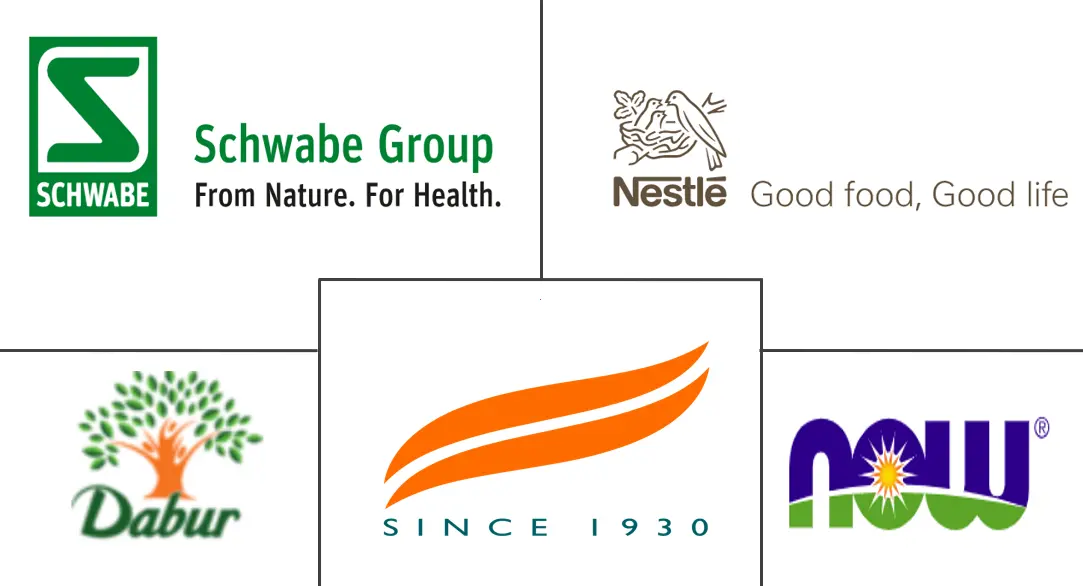
Botanical Supplements Market Analysis by Mordor Intelligence
The Botanical Supplements Market size is estimated at USD 57.31 billion in 2025, and is expected to reach USD 82.30 billion by 2030, at a CAGR of 7.51% during the forecast period (2025-2030).
This growth is driven by the increasing integration of traditional medicine with modern scientific advancements, along with clear regulatory oversight from the United States Food and Drug Administration (FDA). The adoption of advanced technologies, such as artificial intelligence in extraction processes, vertical farming, and plant-cell culture, is helping to reduce variability in raw materials, improve consistency in production batches, and shorten lead times. These advancements are making high-quality, premium formulations more widely available to consumers. In regions like Latin America and Asia-Pacific, regulatory harmonization is facilitating cross-border e-commerce, enabling companies to expand their reach. Updated European Union regulations on hydroxyanthracene derivatives are encouraging faster reformulation of products to meet compliance standards. Companies are also investing in clinical studies to substantiate their product claims, while retailers are focusing on offering curated selections of clean-label and non-synthetic products. The competitive landscape is moderately concentrated, with the top five companies collectively holding a significant share of the global market value.
Key Report Takeaways
- By type, single botanical supplements held 62.12% of the botanical supplements market share in 2024, whereas combination formulations are projected to expand at a 9.55% CAGR through 2030.
- By form, tablets led with 33.34% revenue share in 2024, while gummies are set to register the fastest 9.21% CAGR to 2030.
- By functionality/health benefit, digestive and gut health products accounted for a 35.67% share of the botanical supplements market size in 2024; immune support is advancing at an 8.02% CAGR through 2030.
- By distribution channel, specialty and health stores commanded 72.11% of revenue in 2024, yet online retail is growing at a 7.89% CAGR.
- By geography, North America controlled 32.1% of global revenue in 2024, whereas Asia-Pacific is forecast to climb at an 8.43% CAGR to 2030.
Global Botanical Supplements Market Trends and Insights
Drivers Impact Table
| DRIVER | (~) % IMPACT ON CAGR FORECAST | GEOGRAPHIC RELEVANCE | IMPACT TIMELINE |
|---|---|---|---|
| Increasing consumer demand for natural and organic health products | +1.8% | Global, with the strongest impact in North America and Europe | Medium term (2-4 years) |
| Strategic marketing through celebrity and influencer endorsements | +0.9% | North America and Europe, expanding to Asia-Pacific | Short term (≤ 2 years) |
| Consumer preference shift toward plant-based ingredients over synthetic alternatives | +1.5% | Global, led by developed markets | Long term (≥ 4 years) |
| Integration of traditional medicine practices driving botanical supplement adoption | +1.2% | Asia-Pacific core, spill-over to global markets | Long term (≥ 4 years) |
| Expanding elderly population seeking natural health solutions | +1.0% | Global, concentrated in developed economies | Long term (≥ 4 years) |
| Scientific backing and product innovation | +1.3% | Global, with research and Development centers in North America and Europe | Medium term (2-4 years) |
| Source: Mordor Intelligence | |||
Consumer preference shift toward plant-based ingredients over synthetic alternatives
Consumers are increasingly aware of environmental concerns and are becoming more cautious about synthetic or petrochemical-based additives, leading to a growing preference for plant-based ingredients. Innovations in extraction technologies, such as supercritical CO₂ and ultrasonic methods, have enabled the production of highly concentrated botanical actives while minimizing environmental impact. Regulatory bodies, like the European Medicines Agency, have introduced clearer and more streamlined guidelines for registering plant-based actives, simplifying compliance for manufacturers[1]Source: Food and Drug Administration, "Dietary Supplements," fda.gov. For instance, these guidelines have reduced the time and complexity involved in bringing new botanical products to market. Brands are actively responding to this trend with new product launches. For example, Holland & Barrett introduced a range of plant-based supplements targeting immunity and stress support in 2024, featuring ingredients like ashwagandha, elderberry, and turmeric. Advancements in traceability systems are enhancing consumer confidence by ensuring that botanical ingredients are safer and more sustainable.
Increasing consumer demand for natural and organic health products
Consumers are increasingly choosing botanical and organic supplements as part of a growing trend toward natural and healthier lifestyles. This shift is strongly supported by clean-label regulations, particularly in regions like Europe, which focus on ensuring transparency and traceability in how these products are sourced and manufactured. Regulatory agencies, such as the United States FDA, are also playing a critical role by enforcing accurate and truthful labeling standards. For example, these regulatory agencies require companies to verify the identity of botanical ingredients and provide evidence to support health claims under the Dietary Supplement Health and Education Act (DSHEA)[2]Source: European Medicine Agency, "Good manufacturing practice," ema.europa.eu. These regulations push brands to maintain detailed documentation, which helps build trust and credibility with consumers. Despite being priced 15–20% higher than conventional products, botanical supplements continue to see strong demand. Even price-sensitive consumers are willing to pay the premium, as they perceive the health benefits to outweigh the cost.
Expanding elderly population seeking natural health solutions
The aging global population is driving consistent demand for botanical supplements, particularly those addressing age-related health concerns. The supplement consumption data shows that 81% of Americans aged 55 and above use supplements, and in Germany, over 60% of supplement consumers are 55 years or older, as reported by the Glanbia Nutritionals 2022 report. Elderly consumers demonstrate a preference for botanical supplements with established traditional uses, such as turmeric, ginger, and ginseng, which target common age-related issues. Due to their complex health requirements, older consumers tend to take supplements daily, creating opportunities for personalized products combining immune health with additional benefits. The World Health Organization (WHO) projects that the population aged 60 years and over will increase from 1 billion in 2020 to 1.4 billion by 2030, and reach 2.1 billion by 2050[3]Source: World Health Organization, "Ageing," who.int. This combination of aging demographics and growing acceptance of botanical supplements continues to influence product development and marketing strategies in the market.
Strategic marketing through celebrity and influencer endorsements
The botanical supplements market is gaining significant traction among younger consumers, fueled by marketing strategies that effectively use celebrities and social media influencers to promote natural wellness as a lifestyle choice. These influencers play a key role in simplifying complex scientific information, making botanical products more relatable and appealing to a broader audience. Social media platforms like Instagram and TikTok have become essential for boosting brand visibility. For instance, as of 2025, Grüns Supplements successfully built a community of 250,000 followers and secured USD 500 million in funding by leveraging user-generated content and influencer collaborations. To strengthen credibility, brands are increasingly incorporating results from clinical studies, such as randomized controlled trials, into their marketing efforts. This approach accelerates the adoption of botanical supplements among tech-savvy, younger demographics, helping these products evolve from niche offerings to mainstream lifestyle essentials.
Restraints Impact Analysis
| RESTRAINT | (~) % IMPACT ON CAGR FORECAST | GEOGRAPHIC RELEVANCE | IMPACT TIMELINE |
|---|---|---|---|
| Risk of contamination or adulteration in raw botanical materials | -1.2% | Global, particularly affecting developing country suppliers | Short term (≤ 2 years) |
| Limited availability of sustainable and high-quality raw material sources | -0.8% | Global, concentrated in source regions | Medium term (2-4 years) |
| Presence of counterfeit products | -0.6% | Global, with higher impact in unregulated markets | Short term (≤ 2 years) |
| Growing competition from alternative dietary supplements | -0.9% | Developed markets, expanding globally | Medium term (2-4 years) |
| Source: Mordor Intelligence | |||
Risk of contamination or adulteration in raw botanical materials
The botanical supplements market faces significant challenges related to raw material quality and safety. According to a study published in August 2024 by JAMA Network under Complementary and Alternative Medicine, approximately 4.7% of US adults used at least one of six potentially hepatotoxic botanical products[4]Source: JAMA Network, "Estimated Exposure to 6 Potentially Hepatotoxic Botanicals in US Adults," jamanetwork.com. The risk is particularly pronounced in markets with less stringent regulatory oversight, where adulteration with pharmaceutical compounds or contamination with heavy metals can occur. These safety concerns create market hesitation among consumers and healthcare providers, limiting the broader adoption of botanical supplements. In response, the industry has established initiatives such as the Botanical Safety Consortium, a collaborative forum by the FDA, NIH, and the Health and Environmental Sciences Institute, to develop improved evaluation methods for botanical safety. These ongoing safety challenges and regulatory complexities continue to restrain the market's growth potential despite increasing consumer interest in natural health solutions.
Limited availability of sustainable and high-quality raw material sources
Sourcing consistent, high-quality botanical raw materials continues to be a major challenge, especially as climate change and environmental issues disrupt the production of key adaptogens like ashwagandha, rhodiola, and maca. Factors such as unpredictable weather patterns, rising global temperatures, and soil degradation in key growing regions have significantly impacted crop yields. Export restrictions imposed by governments in countries like Peru and India have further strained the supply chain, creating volatility in the availability of these ingredients. To address these issues, some producers are adopting vertical integration strategies. For instance, farms in India are using advanced techniques like drip irrigation and controlled drying processes to ensure the preservation of active compounds, such as withanolides in ashwagandha, before milling. At the same time, innovations like plant-cell culture systems and aeroponic farming are gaining traction as sustainable solutions.
Segment Analysis
By Type: Combination Formulations Drive Innovation
Single-ingredient products accounted for 62.12% of the revenue in 2024, as consumers continued to rely on well-researched ingredients like curcumin, echinacea, and milk thistle. These products have maintained their dominance due to their long-standing safety profiles and widespread acceptance among healthcare professionals. Their established reputation ensures consistent demand, making them a staple in the botanical supplements market. However, the growing interest in more comprehensive health solutions is driving a shift toward combination formulations, which are projected to grow at a 9.55% CAGR through 2030. These blends appeal to consumers seeking products that address multiple health concerns in a single dose, offering convenience and perceived added value.
The rising popularity of combination formulations aligns with the broader trend of personalized nutrition, where digital tools help consumers identify tailored solutions for their specific health needs. Brands are increasingly incorporating adaptogens, nootropics, and probiotics into multi-functional products, such as once-daily softgels, marketed as comprehensive solutions for various life stages. Retailers are also responding to this demand by dedicating more shelf space to these innovative products, signaling confidence in their market potential. As a result, combination formulations are expected to gain significant traction, gradually closing the gap with single-ingredient products.
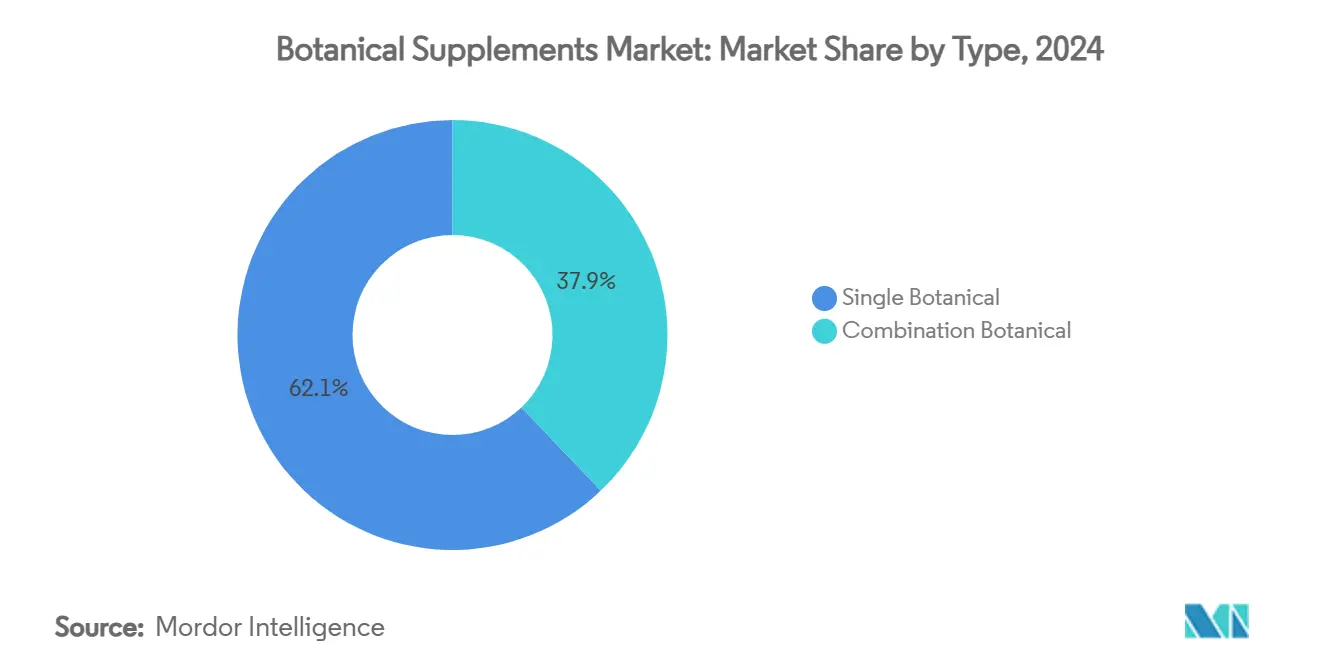
By Form: Gummies Revolutionize Delivery Mechanisms
Tablets accounted for 33.34% of global sales in 2024, driven by their affordability, long shelf life, and precise dosing capabilities that align with pharmaceutical standards. These attributes make tablets a preferred choice for cost-conscious consumers and ensure their continued presence in pharmacies and drugstores. However, gummies and chews are rapidly gaining traction, with an expected annual growth rate of 9.21%. Gummies and chews are reshaping the botanical supplements market by appealing to consumers who dislike traditional pill formats. Their pleasant taste and ease of consumption make them particularly popular among families and individuals seeking a more enjoyable supplement experience.
Advancements in gummy production technology have addressed previous challenges, such as high sugar content and moisture issues. Innovations like starch-free molds, pectin-based gelling agents, and low-glycemic sweeteners have enabled the creation of gummies that cater to diverse dietary preferences, including vegan, keto, and diabetic-friendly options. Leading brands are now offering zero-added-sugar gummies sweetened with plant-based stevia, which maintains a desirable texture and flavor. These improvements have expanded the appeal of gummies beyond children to adult consumers, with products targeting specific health needs such as sleep support, cognitive enhancement, and immune health.
By Functionality: Immune Support Accelerates Growth
In 2024, digestive and gut health products accounted for 35.67% of the market's revenue, reflecting the increasing recognition of the link between gut health and overall wellness. Products that combine digestive enzymes with herbal extracts provide quick relief for gastric discomfort, while synbiotic blends help improve gut microbial diversity. Growing consumer awareness of the gut-brain connection has driven repeat purchases and high adherence to these products. At the same time, immune support products are emerging as a fast-growing segment, with an 8.02% CAGR. This growth is fueled by heightened health awareness following the pandemic and scientific validation of botanicals like Andrographis paniculata and Rhodiola rosea, which are known for their ability to regulate immune responses and promote overall health.
Manufacturers are innovating by combining beta-glucan-rich mushrooms with antioxidant-packed berries to create versatile immune-support products, such as soft chews and effervescent powders. Immune health claims now account for 33% of all new product launches in the botanical supplements market, highlighting the segment's growing importance. Related categories such as stress relief, sleep support, and cognitive health are also gaining momentum. These segments often utilize adaptogenic ingredients, enabling companies to optimize raw material usage while addressing multiple consumer needs within the botanical supplements market.
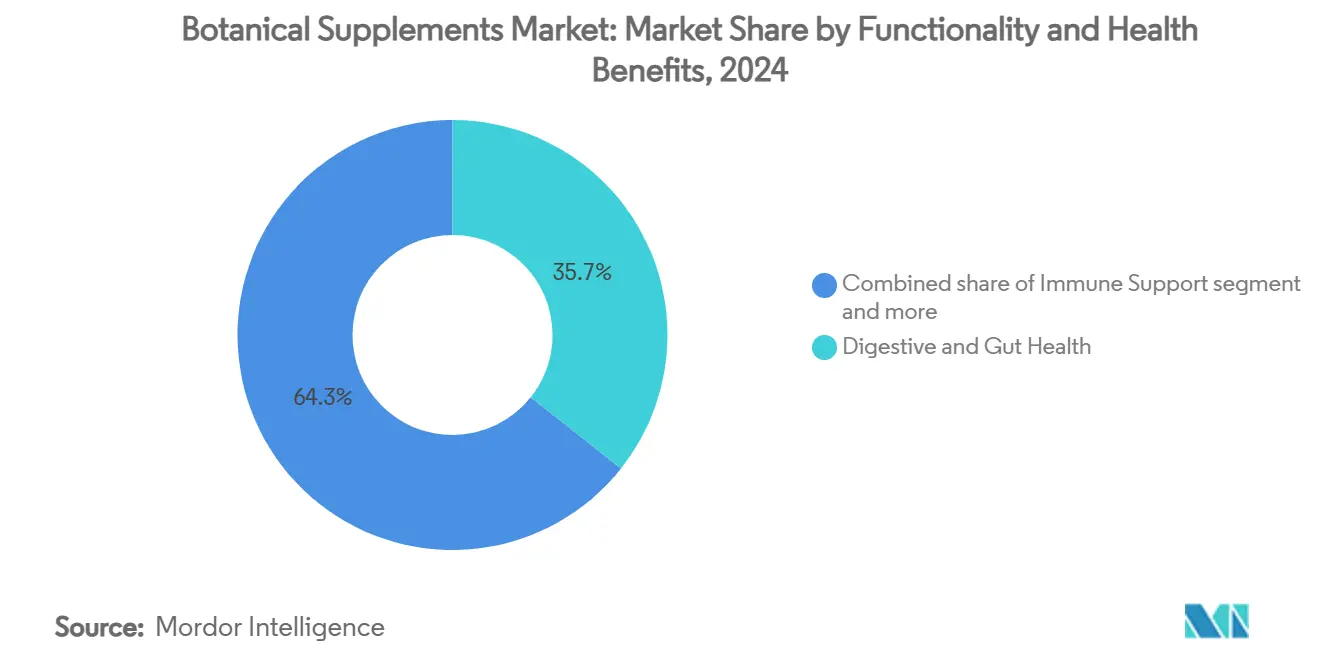
Note: Segment shares of all individual segments available upon report purchase
By Distribution Channel: Digital Transformation Accelerates
Specialty and health retailers account for 72.11% of 2024 revenue, driven by their curated product selections and knowledgeable staff who help customers understand botanical supplement benefits. This retail format enables premium pricing as consumers demonstrate a willingness to pay more for professional guidance. E-commerce channels are projected to grow at a 7.89% CAGR, exceeding other distribution channels, as consumers embrace subscription services and home delivery options. Digital platforms utilize AI technology to analyze consumer behavior and recommend product combinations that increase purchase value.
International e-commerce platforms enable Asian manufacturers to sell certified products directly to United States and European consumers, reducing intermediary costs and expanding market reach. Online retailers differentiate themselves through subscription services, incorporating home testing kits for personalized supplement recommendations, and building valuable consumer data assets. While supermarkets and pharmacies adopt digital solutions like QR codes and pickup lockers, they continue to lose market share as younger consumers prefer mobile shopping platforms.
Geography Analysis
North America remained the leading region in the botanical supplements market in 2024, capturing a 32.10% revenue share. A well-established regulatory framework, advanced research infrastructure, and a growing focus on preventive health among consumers drive this dominance. The FDA’s updated New Dietary Ingredient notification guidance has streamlined the process for introducing new products while ensuring high safety standards. Research hubs in states like California and Massachusetts continue to validate the efficacy of innovative plant-based extracts, which have strengthened consumer trust and scientific credibility. These factors collectively contribute to the region's strong market position.
The Asia-Pacific region is emerging as a key growth driver for the botanical supplements market, with a projected CAGR of 8.43%. Government initiatives integrating traditional medicine systems like Ayurveda, Traditional Chinese Medicine, and Kampo into public health programs are fueling this growth. For example, China’s Healthy China 2030 initiative highlights the government’s commitment to promoting health and wellness, while Japan’s Foods with Function Claims framework has simplified the approval process for functional food labels. Multinational companies are investing in local cultivation and extraction facilities to overcome export restrictions and benefit from favorable tariffs under Regional Comprehensive Economic Partnership agreements. Domestic start-ups are leveraging their cultural heritage to create niche products for e-commerce platforms, often targeting diasporic communities.
Europe presents a mixed outlook. Demand remains robust in Germany, France and Italy, yet the 2025 ban on hydroxyanthracene derivatives forces reformulation of certain laxative herbs like senna and aloe. Manufacturers allocate capital toward high-performance thin-layer chromatography to confirm compliance and sustain market access. The European Food Safety Authority continues to harmonize monographs, reducing national fragmentation. Eastern European economies, notably Poland and Romania, enjoy double-digit volume growth as incomes rise and pharmacy chains expand shelf space.
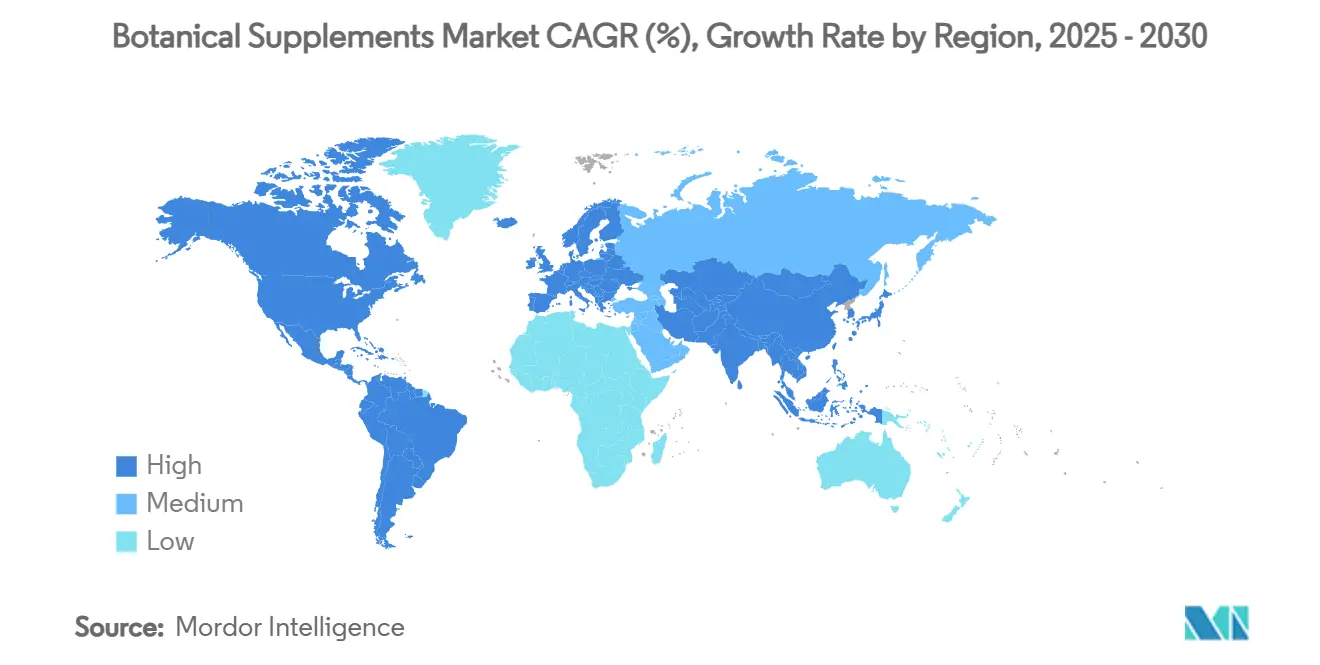
Competitive Landscape
The botanical supplements market is moderately concentrated, with the top five companies holding a significant share of the overall market. This level of concentration reflects a competitive landscape where established multinationals are expanding their presence in the botanical space through strategic acquisitions. For example, Dr. Willmar Schwabe recently acquired Enzymatic Therapy, leveraging its Nature’s Way brand to strengthen its foothold in the United States market.
Technological advancements are becoming a key differentiator in the market. Companies like Brightseed are utilizing artificial intelligence to explore botanical metabolomes and discover new bioactive compounds, partnering with vertical farming pioneers like Botalys to commercialize rare ingredients.
Marketing strategies are also playing a crucial role in shaping the botanical supplements market. Companies are allocating significant portions of their revenue to influencer partnerships, short-form video campaigns, and wellness app integrations to engage consumers effectively. Loyalty programs are being designed to reward repeat customers with personalized dosage recommendations based on symptom-tracking tools. Collaborations between functional beverage and supplement brands are blurring category lines, with powdered botanical blends now appearing in ready-to-drink formats co-branded with major energy drink companies.
Botanical Supplements Industry Leaders
-
Nestle SA
-
Dr. Willmar Schwabe GmbH & Co. KG
-
NOW Foods
-
Himalaya Global Holdings Ltd.
-
Dabur India Ltd.
- *Disclaimer: Major Players sorted in no particular order
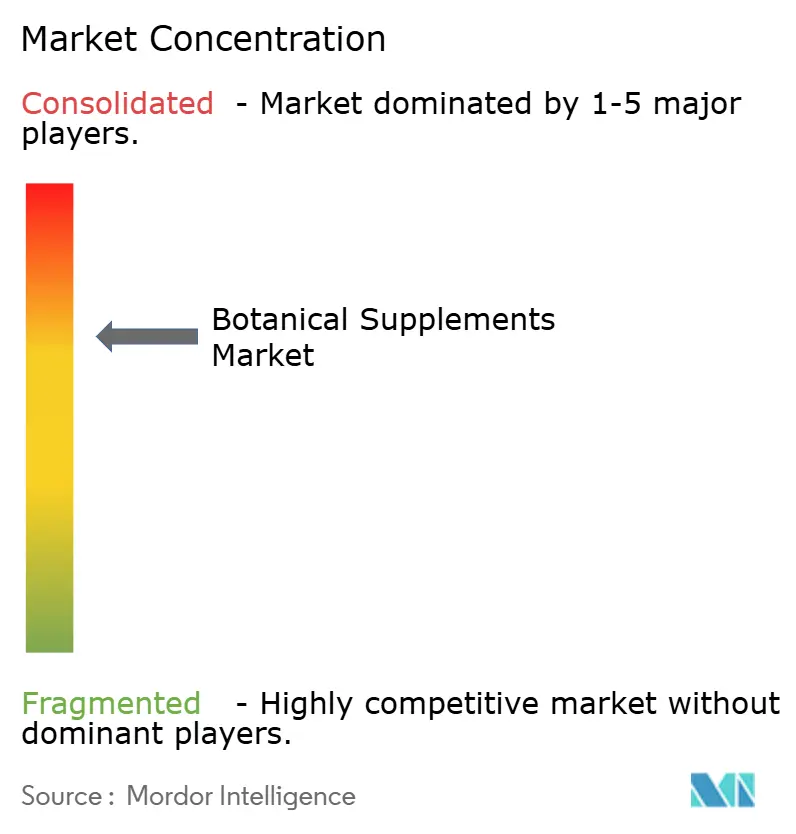
Recent Industry Developments
- April 2025: Vivazen introduced botanical gummies to expand its functional plant-based supplements portfolio. The product line features three formulations: Berry Bliss for energy and focus, Cider Crush for stress relief, and Citrus Chill for relaxation, with effects reported to begin within 20 minutes.
- December 2024: Himalaya Wellness has launched a new 28-count bottle of PartySmart, featuring a clinically tested herbal formulation. The product supports liver function during alcohol metabolism and aids in reducing acetaldehyde, a compound produced during alcohol breakdown that can cause morning-after discomfort. The single-capsule dosage, taken during alcohol consumption, aims to improve post-celebration recovery.
- August 2024: Dabur India Limited received board approval to invest ₹135 crore in a new manufacturing facility in the SIPCOT industrial zone near Tindivanam, Tamil Nadu. The facility, which marks the company's first plant in South India, will manufacture Ayurvedic healthcare, personal care, and home care products, including Dabur Honey, Red Paste, and Odonil.
Global Botanical Supplements Market Report Scope
Botanical supplements are products derived from plants, plant parts, or plant extracts intended for internal consumption. The botanical supplements market is studied and segmented into type, form, functionality/health benefit, distribution channel, and geography. Based on type, the market is segmented into single botanical and combination botanical; by form, it is segmented into tablets, capsules/softgels, gummies & chews, powders and others; by functionality/health benefit, into digestive & gut health, stress, sleep & cognitive health, immune support and others; by distribution channel into, supermarkets/hypermarkets, specialty & health stores, online retailers and other distribution channels. Based on geography, the market studied is segmented North America, Europe, Asia-Pacific, South America, and Middle East & Africa. The report contains the top-line revenues and detailed qualitative analysis of the global key players, highlighting the most adopted strategies and recent developments of the companies in the market studied.
| Single Botanical |
| Combination Botanical |
| Tablets |
| Capsules/Softgels |
| Gummies and Chews |
| Powders |
| Others |
| Digestive and Gut Health |
| Stress, Sleep and Cognitive Health |
| Immune Support |
| Others |
| Supermarkets/Hypermarkets |
| Specialty and Health Stores |
| Online Retailers |
| Other Distribution Channels |
| North America | United States |
| Canada | |
| Mexico | |
| Rest of North America | |
| Europe | Germany |
| France | |
| United Kingdom | |
| Spain | |
| Netherlands | |
| Italy | |
| Sweden | |
| Poland | |
| Belgium | |
| Rest of Europe | |
| Asia-Pacific | China |
| India | |
| Japan | |
| Australia | |
| South Korea | |
| Indonesia | |
| Thailand | |
| Singapore | |
| Rest of Asia-Pacific | |
| South America | Brazil |
| Argentina | |
| Chile | |
| Colombia | |
| Peru | |
| Rest of South America | |
| Middle East and Africa | United Arab Emirates |
| South Africa | |
| Nigeria | |
| Saudi Arabia | |
| Egypt | |
| Morocco | |
| Turkey | |
| Rest of Middle East and Africa |
| By Type | Single Botanical | |
| Combination Botanical | ||
| By Form | Tablets | |
| Capsules/Softgels | ||
| Gummies and Chews | ||
| Powders | ||
| Others | ||
| By Functionality/Health Benefits | Digestive and Gut Health | |
| Stress, Sleep and Cognitive Health | ||
| Immune Support | ||
| Others | ||
| By Distribution Channel | Supermarkets/Hypermarkets | |
| Specialty and Health Stores | ||
| Online Retailers | ||
| Other Distribution Channels | ||
| By Geography | North America | United States |
| Canada | ||
| Mexico | ||
| Rest of North America | ||
| Europe | Germany | |
| France | ||
| United Kingdom | ||
| Spain | ||
| Netherlands | ||
| Italy | ||
| Sweden | ||
| Poland | ||
| Belgium | ||
| Rest of Europe | ||
| Asia-Pacific | China | |
| India | ||
| Japan | ||
| Australia | ||
| South Korea | ||
| Indonesia | ||
| Thailand | ||
| Singapore | ||
| Rest of Asia-Pacific | ||
| South America | Brazil | |
| Argentina | ||
| Chile | ||
| Colombia | ||
| Peru | ||
| Rest of South America | ||
| Middle East and Africa | United Arab Emirates | |
| South Africa | ||
| Nigeria | ||
| Saudi Arabia | ||
| Egypt | ||
| Morocco | ||
| Turkey | ||
| Rest of Middle East and Africa | ||
Key Questions Answered in the Report
What is the current value of the botanical supplements market?
The botanical supplements market size is USD 57.31 billion in 2025.
How fast is the botanical supplements market expected to grow?
The market is forecast to expand at a 7.51% CAGR, reaching USD 82.30 billion by 2030.
Which region will post the highest growth through 2030?
Asia-Pacific leads in growth with an expected 8.43% CAGR, driven by integration of traditional medicine and rising incomes.
What delivery format is growing fastest?
Gummies and chews exhibit the highest growth rate at 9.21% CAGR due to superior taste and convenience.
Page last updated on:
